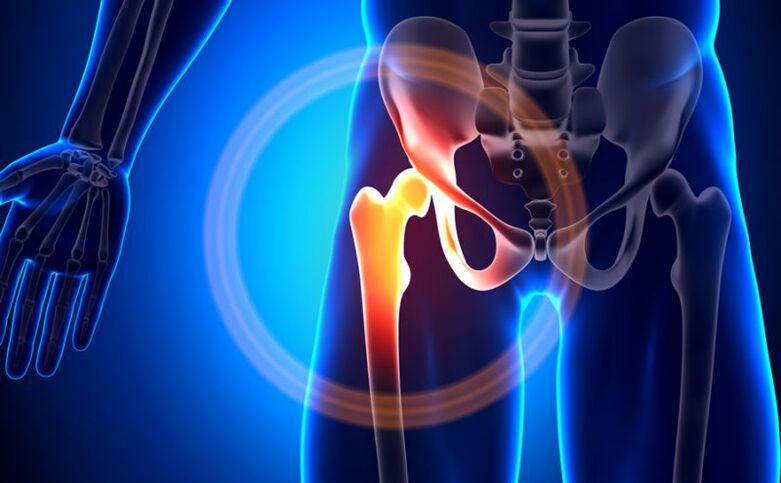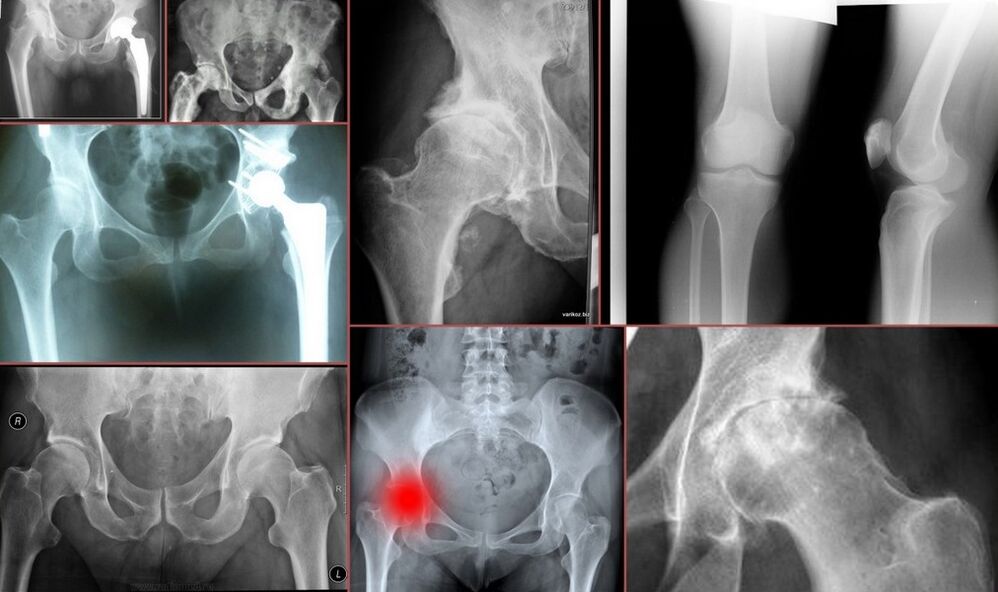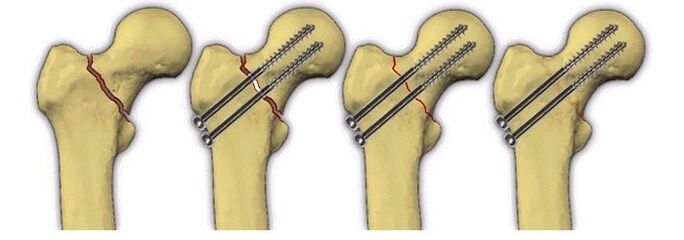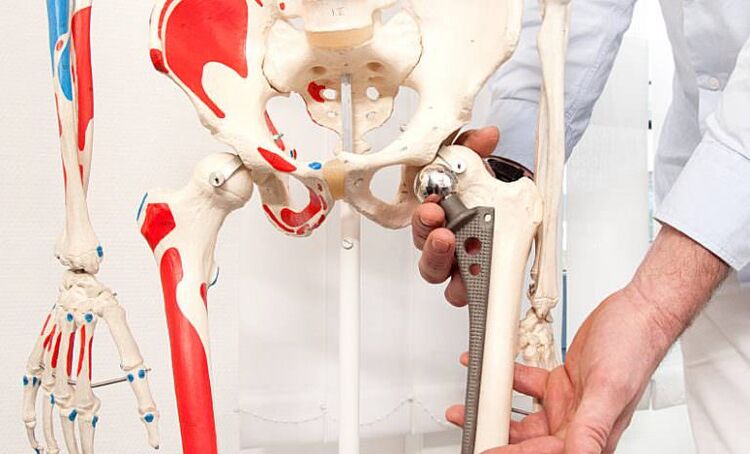The hip joint is the junction of the thigh with the pelvis. The articulations are arranged in such a way as to give any direction of foot movement. This feature causes the possibility of various damages. The problem causes pain in the hip joint.
The constituent parts of the articulation undergo painful changes.
Characteristics of the cause of pain
injuries
When there is pain in the hip joint, radiating to the legs and buttocks, the pathological cause can be:
- Congenital dislocation due to unsuccessful childbirth. Damage is diagnosed immediately in the newborn. Babies have uneven folds on the back, shortening the legs. Often there are pinched nerves.
- Traumatic dislocation. It is characterized by pain when moving the leg to the side, impossible to stand or sit. Hematomas and swelling develop in the joint area. Hip dislocation requires immediate treatment of the victim.
- Broken neck. The diagnosis is more common in women over 60 years of age. The provocateur of what hurts in the right thigh in the upper part of the woman is a shallow fall. With a fracture, a sharp pain is felt, which increases with movement. Very unpleasant discomfort gives in the thighs. The damaged area swells, bruises develop over the joints. The injured limb becomes shorter, the lameness develops. If the injury pinches the nerve, the hip becomes numb.
- Joint injuries. The pain is mild, but increases with active movement. In a static posture, the symptoms disappear. Such injuries are typical for people prone to falls. The victim was paralyzed, but the condition quickly passed.
- Broken perforated. The pain is moderate or severe. Movement worsens symptoms. Maybe the nerves are pinched, where the pain spreads, the limbs become numb.

Traumatic injuries are a common cause of back pain in the pelvis. Serious fractures or dislocations often require surgery. If the nerve is pinched, numbness of the legs has begun - immediately rush to the doctor.
Systemic diseases
Pain in the joints can trigger systemic pathology of connective tissue. Therapy of such diseases should be carried out continuously, as it is almost incurable. Treatment is complex organized, it must affect the cause of discomfort.
Such diseases can trigger pain:
- Bechterew's disease. The pain is dull, worse at night. More often the pelvic bones ache, radiating to the knees, groin, thighs. Movement is difficult, the person is restrained. Inflammation develops in the joints.
- Reiter's syndrome. The disease is characterized by damage to the genitourinary organs, joints and inflammation of the conjunctiva. Pathology refers to an autoimmune disease, developing as a result of an intestinal infection. Pain in the hip joint that radiates to the groin begins to be felt a few weeks after the infection. The pain syndrome is acute, the temperature rises. The pelvis is swollen. Often, the disease causes symmetrical damage to the joints.
- Rheumatoid arthritis. The problem is characterized by inflammation of the connective tissue. With pathology, the joints never purulent. This disease is a precursor of coxarthrosis. At first, there is swelling, shooting pain, discomfort during walking. In the joints, the temperature rises, then the stiffness of movement develops. Significant pain in the hip joint is located on the side at night. Pathology is shown on the right and on the left. Due to the destruction of the joints, the nerves are pinched.
Degenerative changes
The cause of pain in the hip joint, and rather sharp, pulling or burning, is a degenerative change as a result of the disease:
- Varus juvenile disability. There was an interesting pain creeping into the knee. Sports training increases the intensity of the syndrome.
- Coxarthrosis. Pathology is diagnosed in people of both sexes. It is treated for a long time, and the therapy is quite complicated. The disease is characterized by the development of degenerative and destructive processes in the joints. Signs of the disease: patients experience joint pain as a result of walking long distances, running or climbing stairs. In other cases, the discomfort passes. Then the inside of the thigh hurts, the pain is given to the groin. Daily exercise greatly enhances the sensation, but during rest the discomfort disappears. Due to long walks, lameness forms, the joints begin to click. Muscle tone worsens, tendon work is disrupted. With the advanced stage of the disease, relatively severe pain is observed at night, the lameness is already obvious. Immobility develops when muscles atrophy, losing volume. Therapy can stop joint destruction.

Such diseases give rise to persistent lameness, as a consequence - a person is limited in his work activities, unable to train fully. Even getting out of bed in the morning is difficult.
Causes of inflammation or contagion
In addition to direct damage to the joints, inflammation of the articular bags, tendons or muscles can cause discomfort. Infectious diseases also cause pain in the pelvis in women and men:
- Arthritis tuberculosis. Pathology mainly affects young children with weakened immune systems. The child is quickly tired, runs a little. Thigh muscles begin to atrophy, legs shorten, click joints. Gradually, a strong pain syndrome develops in the affected joint. Sometimes the pain is sharp, but more often it is burning or pulling. Later, suppuration develops in the joints, which increases symptoms.
- Purulent arthritis. With such a disease, the temperature rises, the skin around the joints becomes red, swelling can be seen, and a sharp or acute pain is felt. Any load (banal getting out of bed) is painful. It hurts to crawl. Therapy should not be delayed, because a person is suffering from sepsis.
- Bursitis is an inflammation that affects the joint bags. The main symptom is pain that spreads down the legs. It is acute, when standing discomfort increases. When the limb is not loaded, the pain only burns.
- Aseptic necrosis of the femoral head. Most pathologies develop in young men. Causes the disease of deterioration of blood circulation in the hip joint. Tissue cells die due to necrosis. The disease is characterized by acute pain radiating to the groin, a strong burning sensation in the affected area. It was so painful that the young man lost the ability to lean on his feet, it was hard for him to get out of bed in the morning. Often, only analgesic injections help the patient. After a few days, the pain symptoms disappeared. As the pathology progresses, changes occur in tendons and muscles that atrophy. Walking disorders develop due to lameness.
In infectious pathology, different pains develop: a burning, dull or exciting sensation. The discomfort increases so much that it interferes with sleep at night. Any such disease requires immediate treatment.
Treatment
Although the pain in the hip joint is intermittent, it must be treated without fail. The method of therapy depends on the provocateur of the symptoms.
congenital dislocation
When the dislocation is congenital, the baby is placed on the joint with orthopedic products: props, stirrups, it is recommended to use Freik pillows. Such funds help keep the limbs of the newborn in a physiological position. Babies need to be in such a state for at least six months.
When traditional treatments fail, babies need surgery. Surgically, the bone head is fixed in place in the newborn, at the same time correcting other deficiencies. Once the orthopedic device has been removed, the child is shown a light massage to strengthen the muscles.
Traumatic dislocation
When there is a traumatic dislocation, the doctor prescribes medications that relieve muscle tone, and then fixes the hip in place. After this, the patient should calm down. If there is numbness in the limbs, it means that the nerve is pinched. In such cases, you can not do without examination by a neurologist.
Bechterew syndrome
Therapy for Bechterew's disease is performed in a complex way. This helps reduce the intensity of symptoms caused by the inflammatory process. Treatment consists of taking medications (immunosuppressants, hormone medications, anti-inflammatory drugs), physiotherapy, and therapeutic exercise (muscle stretching is especially useful). The recommended massage of the affected joint.
Preparation along with therapeutic training is prescribed only by a traumatologist, surgeon or orthopedic specialist. To strengthen the pelvic muscles, you need to swim more. In difficult situations, the patient is prescribed joint replacement.
Broken hip
Such injury therapy is carried out by a traumatologist. Surgery is recommended for patients, as conservative treatment is rarely effective. However, if it is impossible to perform surgery, the patient is given a cast plaster from the heel to the lower back. In older people, such damage rarely grows together - the recovery process takes months.
Among the consequences of the disease, a reduction in the function of the cardiovascular and respiratory systems is distinguished, because the patient does not have the opportunity to move normally and lead an active lifestyle. Just sitting is problematic for him.
When a joint is broken, there is a burning sensation in the soft tissues. During a surgical intervention, fixation of the bone body and head with pins or screws is used for treatment; in difficult cases, endoprosthesis is performed.

Reiter's disease
In the treatment of Reiter’s pathology, antibiotics, glucocorticosteroids, anti-inflammatory drugs, drugs that suppress the immune system, and topical ointments are used. Therapy lasted more than four months. Even adequate treatment does not prevent the likelihood of the disease recurring.
The entire recovery period is required to maintain muscle tone with traditional physical exercises - stretching.
Rheumatoid arthritis
The most common cause of hip pain in women and men is rheumatoid arthritis. Pathology can cause severe pain, it is impossible to get rid of it completely. However, drug therapy should be used to improve quality of life. Hormonal agents, cytostatics, non-steroidal anti-inflammatory drugs, antirheumatic drugs are used.
Surgical intervention is used only when the disease is advanced, when the patient is practically unable to walk and sit. Recommend joint repair or arthroplasty. Physical exercise, local ointments are useful.

Coxarthrosis
Coxarthrosis therapy aims to eliminate the cause of the unpleasant symptoms. Pathology is initially treated with conservative methods. Patients are recommended to be shown non-steroidal anti-inflammatory drugs, chondroprotectors, drugs that increase blood circulation.
In treatment, warming ointments and painkillers are actively used. In addition, patients are recommended to perform light therapeutic exercises. Often the joints require anesthesia, therefore, with significant discomfort, intramuscular injections are used.
With advanced disease, conservative therapy does not have the desired effect. Any joint strain worsens the well -being of the patient. Without the help of strangers, the patient cannot get out of bed. She needs constant painkillers. In such cases, only surgery can correct the situation.
Often, arthroplasty is performed, but this procedure is contraindicated for older people. Therefore, only additional surgery is recommended for such patients. Surgical treatment is completed with a course of rehabilitation: minimal stretching, simple exercises performed under medical supervision.

Proper therapy helps stop the progression of the disease, eliminating painful symptoms.
Therapeutic features for infectious lesions
If the pain in the hip joint is provoked by an infectious lesion, then you should first contact an infectious disease specialist. How to relieve pain in the hip joint with such pathology? It all depends on the type of disease:
- Tuberculous arthritis is mostly treated conservatively. Patients are required to limit mobility by using tight bandages. When an abscess develops in a soft tissue, it is removed surgically.
- Purulent arthritis. First, anesthesia of the affected joint is performed. For this, intra-articular analgesic injections were used. Antibiotics and antibacterial drugs are used against infections, using different groups simultaneously, which are only prescribed by a doctor. In addition, the abscess was removed. The affected limb must be immobile - the patient is placed on a splint or plaster cast.
- Aseptic necrosis therapy involves restoration of poor blood flow, resorption of dead areas. For limb anesthesia, non-steroidal anti-inflammatory drugs and vitamin complexes, drugs to reduce blood density are used. When the thighs are sore, anesthetic ointments and massage procedures are also prescribed. The disease is still treated with physiotherapeutic agents, therapeutic exercises. In complicated situations, minimally invasive surgery or joint arthroplasty is used.
- Because bursitis causes severe pain, anesthesia needs to be arranged. For this, anti-inflammatory and analgesic drugs are used, introducing them intramuscularly. Steroid medications are used to eliminate severe discomfort quickly. Since the joints are always sore, it needs rest.
Limb numbness, burning and pain in the joints, which radiate to the limbs, are unpleasant sensations that indicate the presence of serious pathology. Sometimes folk recipes help in such situations.
Alternative treatments
When a patient suffers from severe burning pain, problems with tendons are noticeable, but it is contraindicated for him to use drugs - it is permissible to use folk recipes. Although they are not a panacea, however, in complex therapy they can help correct the condition. Before using any folk remedy, you must obtain medical approval for such a procedure.
Here are some suggestions:
- Compressed clay. Such folk remedies help relieve pain and reduce swelling of the joints. Clay is recommended to alternate, first using blue and then black. It is used at night, wrap the compress with a woolen cloth.
- Homemade ointment prepared from white leg roots and visceral fat. Melt the fat, add the roots, chop first with a meat grinder. Put the batter on low heat. After boiling, continue to heat for another 7 minutes. Apply the cooled ointment before bed on the affected joints. Be sure to protect the joints. Such folk remedies perfectly eliminate swelling, other unpleasant symptoms.
- cabbage compressor. Along with them you will need honey. Smear the cabbage leaves with bee products, then apply on the sore area. Cover the compress from above with a plastic bag, cover it all with a woolen cloth. Therapeutic course - a month. It is recommended to do a light massage for the joints in the interval between compresses.
- Lemon, garlic and celery remedies relieve severe pain. To prepare it, take 2 lemon seeds, 130 g of garlic and 300 g of celery (root). Grind the ingredients thoroughly with a meat grinder, pour into a container with a tight lid. Pour boiling water over everything, mix. Close the lid and wrap the plate with a blanket. After 12 hours, drink 1 teaspoon of liquid. before meals for several months.

It should be noted that the pinched nerves that occur in the hip joint, folk remedies can not be eliminated. With limb numbness, be sure to visit a neurologist. Also, don’t forget that any damage to the joint that causes pain must be identified immediately and treated adequately.
Light gymnastics, stretching exercises are able to prevent violations of joint function.































